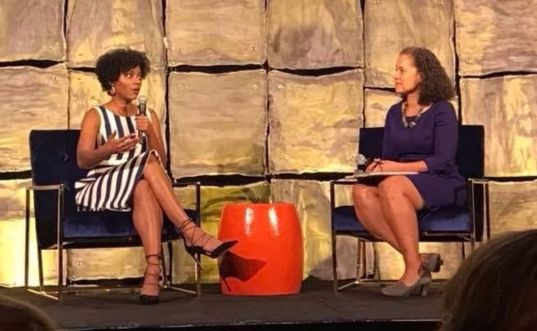
Earlier this fall, seven members of the Safe Connections team attended the 8th Biennial National Conference on Health and Domestic Violence (NCHDV) in San Francisco. Big thanks to the federal Victims of Crime Act for the grant that funded this incredible opportunity for our staffers.
From September 26-28, the conference brought together 1,200 medical, public health, and domestic violence experts working to advance the health care system’s response to domestic and sexual violence.
It would be impossible to share all of the important insights, educational opportunities, and community-building experiences we gained from the NCHDV, so instead, here are our top seven takeaways—one from each Safe Connections attendee:
- LOU, Adolescent Therapist: One of the speakers at NCHDV was a physician from Portland, Oregon. He presented data from empirical research that showed a correlation between a history of trauma and autoimmune and other chronic diseases. The illnesses included diabetes, rheumatoid arthritis, heart disease, skin disorders, allergies, digestive, renal, pulmonary, and other illnesses. The agency had identified specific traumatic markers, including rape, homelessness, physical assault, et cetera, that would indicate a higher risk for chronic disease. With the current life expectancy in the United States at about 80, the presence of 5 or more of the trauma markers would reduce the life expectancy by approximately 25% to about 60. So Safe Connections’ mission of prevention and treatment of trauma, and the advocacy for survivors, is essential to move toward a cultural environment where all humans are assured they can thrive physically, emotionally, and spiritually.
- JANET, Therapist: The conference covered how race intersects with domestic violence extensively. One section, called Collective Liberation – Dismantling White Supremacy, spoke honestly in separate sessions for white people and people of color. One thing from NCHDV that I brought back to my team was the recognition that when you take away a group’s power, that loss of power can manifest in other ways. Higher rates of domestic violence occur within populations that have been marginalized. While this wasn’t new to me, what was new was the way that the facilitators were talking about it – where we’re actually talking about racism as a public health crisis.
- DEANNA, Therapist: Most interesting to me was a physician who presented about a partnership that was formed with an anti-trafficking organization to create a comprehensive clinical care model (medical home), meeting social services and clinical needs. It’s inspiring to have this sort of a model in which a clinic and an anti-human trafficking organization partner successfully to identify signs of trafficking and provide medical care, especially having family medicine residents in this program. It challenged me to think about what anti-trafficking organizations in the St. Louis area and those in the medical field can do so that trafficking survivors don’t fall through the cracks.
- JESS, Assistant Director for Crisis and Prevention: One of my biggest takeaways from NCHDV includes the presentations facilitated by Michael Munson, the founder of FORGE. Principally, the presentations focused on the intersection of survivorship and both trans and non-binary identities, backed with data from a national survey of sites working with trans and non-binary audiences. As there tends to be a lack of trans and non-binary representation in national data, this lent tangible (as opposed to anecdotal) quantitative credibility to the importance of maintaining an inclusive lens, particularly when working with survivors of violence.We know that minority populations experience higher rates of violence than their counterparts; these presentations let us really see that impact. These presentations were especially powerful for me in my role at Safe Connections because of my work in Prevention Education where I’m supporting curriculum development and regularly interacting with young people, who currently maintain the highest percentage of individuals identifying particularly as non-binary.
- CINDY, Crisis and Community Outreach Coordinator: One important aspect of community outreach is the ability to collaborate with local hospitals and healthcare professionals. By providing education on the effects of violence and health, healthcare professionals then have the unique opportunity to identify victims of abuse and connect them to community support in a way that makes the client feel safe. Unwanted pregnancies, chronic pain, and traumatic brain injuries (which can happen after strangulation) are all examples of ways that intimate partner violence can manifest physically. It’s so important that health care professionals identify and treat the root of these problems. This is why we’re needed in providing trainings to healthcare professionals—so that we can create a partnership that promotes holistic access to care for survivors.
- KYLA, Support Services Therapist: After being immersed in a three-day anti-violence conference, it’s hard to pick just one thing that left the biggest impression on me. The two performance pieces we saw—Spoken Word by Terisa Siagatonu and Jenae Johnson, and a short theatrical performance by Sarah Jones—were personally refreshing and revitalizing. The two workshops at that were most impactful to me in terms of supporting Safe Connections in continuing to grow as an agency were about vicarious trauma resilience through organizational response, and collective liberation through white people working to dismantle white supremacy.
- MINDY, Therapist: My takeaways from NCHDV were: Screening for TBI (traumatic brain injury), and learning about NMBIAC’s brain injury screening tool. Looking at how we can implement TBI screening in our assessment process and possibly provide referrals to our clients for medical evaluations. Unfortunately, many people that have experienced head trauma as well as strangulation often experience neurological issues that go undetected and undiagnosed. This is a significant issue for some of our clients. Also, looking at how Safe Connections can better support direct service staff, particularly therapists with using the The Vicarious Trauma—Organizational Readiness Guide (VT–ORG), which was created by exploring both practice wisdom and research literature on organizational strategies that reduce, or have the potential to reduce, the impact of vicarious trauma—the exposure to the trauma experiences of others.